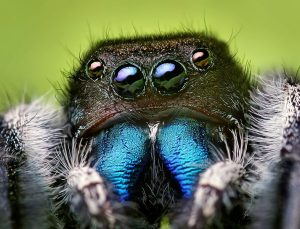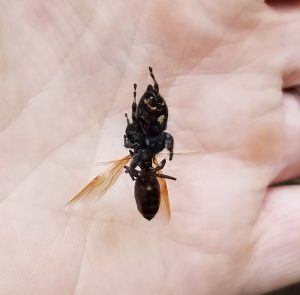It’s rare that a creature as small as a spider could be aware of a human in such a charismatic way, but that’s the nature of the jumping spider. With two pairs of forward-facing eyes set on a flat face (along with two other pairs pointing outward) the jumping spider is a predator that relies on its keen vision to find prey—even as it evades predators and keeps an eye on you. No larger than an inch (and mostly much smaller), these spiders are harmless to humans but present in our environment in all but the coldest weather. They seem to thrive in the complex outdoor spaces that we create with our homes, sheds, landscapes, patio furniture and gardens.

Why? Because there are plenty of spaces for hiding and lots of prey.
Jumping spiders make up the largest group of spiders in the world—about 13 percent of those we’ve named. While most are found in the tropics, over 300 species of jumping spiders inhabit North America. They are mainly carnivorous, meaning they are hunters. Sometimes jumping spiders incorporate nectar into their diets, and one species is known to feed on plant matter—making it unique among all spiders. As hunters, jumping spiders use a variety of strategies, from ambushing prey to sneakily dropping down on their victims from above.
Like most spiders, they extrude silk from silk glands at the rear end of their abdomen, but jumping spiders don’t spin webs. They use their silk as a safety line for rappelling and to remember where they’ve been. Jumping spiders can take prey much larger than themselves. Like all spiders, they subdue their prey with venom from their jaws, aka chelicerae.
One of the truly remarkable things about jumping spiders is their ability to … you guessed it … jump. With those big binocular eyes, they calculate the distance of a leap and the position of prey before leaping. Once airborne, they drop that silk line for safety.
Jumping spiders have also have elaborate mating rituals. These include drumming and vivid dancing by male spiders hoping to attract females. The peacock spider is a great example.
So what does this have to do with IPM? Sometimes just understanding the creatures we see in our everyday lives can have an impact on our feelings about killing them. Many people have negative feelings about spiders. Yet most are completely harmless and never infest homes. They are serious predators of flies, mosquitoes and other pest insects. In fact, the ecological services of spiders are much larger than we can measure.

Consider the ways you manage your home landscape, especially the areas around the perimeter of the house or building. Reducing the use of insecticides can help conserve beneficial arthropods like jumping spiders. Most home landscapes never need insecticides for management. If a shrub or a plant has persistent pest issues, such as aphids or mites, it might not be worth keeping. Just remove that problem plant and replace it with something better adapted and pest-free. After all, choosing the right plant for the right place is core to good IPM.
Meanwhile, keeping mulch away from the foundation (consider a pebble border) can help keep insects such as ants out of your house. Make sure those shrubs and trees around the home are not touching the side of the building to eliminate the bridge from landscape to house and the need for perimeter insecticide use.
Creating a more sustainable landscape encourages beneficial arthropods—the spiders and such—naturally found in your yard. Spiders, mysterious and creepy as they might seem, are top predators of insect pests. As the charismatic ambassadors of the spider world, jumping spiders remind us that it’s OK to live and let live.